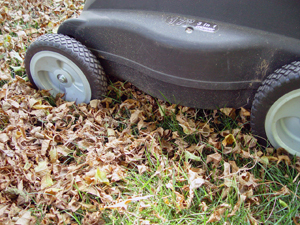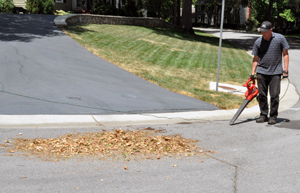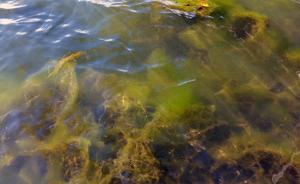Mulch Mowing Fall Leaves
 Why fall leaf management matters for lawns and landscapes
Why fall leaf management matters for lawns and landscapes
Like clockwork it happens every fall with the changing of the seasons. This annual change has an effect on many of us as we deal with the bounty of falling leaves. The trees have given us so much during the summer, from shade, homes for wildlife, and the beauty of the changing of color with the seasons. Once the leaves begin to fall we usually forget about their beauty and think of the mountain of leaves as work.
I can remember being handed the old fashioned rake, which appeared to be an inch wide compared to the size of the area to be raked. With each sweep of the rake it seemed like the lawn grew bigger and progress was slow, at best. Shoulders began to ache, callouses appeared on the hands and the project became boring work that seemed like it would never end.
I dreaded raking the leaves. I felt fortunate as I did not have knee deep piles to pick up. My goal was to find creative ways to avoid retrieving the rake from the hanger in the garage. Being a good Extension agent I did my homework and researched alternatives to leaf raking. I am glad to report that the rake rarely gets dusted off now. I found that managing fallen leaves takes a creative approach and judicious use of the lawn mower. I am here to tell you it works if you follow a few simple guidelines and strategies.
How to mulch mow leaves back into your lawn
The first step to avoid raking is to embrace the concept of mulch mowing. Mulch mowing is basically what it sounds like. The leaves are mown back into the turf and turned into mulch like material that is returned to the soil. Years of research at leading land grant universities such as Michigan State have shown this process is efficient and actually benefits the lawn when properly done.
It is simple, with only one drawback. The drawback is more frequent mowing, which still beats hand raking. Frequent mowing is the key for successful mulch mowing. Mowing during the leaf season is not based on grass growth but on the rate at which leaves fall and collect on the lawn. Mow each time a thin layer, an inch or so of leaves cover the turf. This thin layer is chopped by the mower and then filters through the leaf blades where it works its way down to the soil, naturally composting and returning nutrients to the soil.
This process of frequent mowing can continue as long as the shredded leaves do not start to pile up on top of the turf and shade out the grass. Research has shown if done properly six inches or more of fallen leaves can be chopped by the mower and returned to the soil without causing damage. Let me repeat this important point. This is a series of frequent mows over a period of time which reduces up to six inches or more of leaves into fine mulch that filters back into the turf. This is not waiting until six inches of leaves blanket the lawn. I have practiced this approach on my own lawn for several years with great success.
Another trick to help this process become more effective is proper fertilization. This may be an added bonus as normally our cool season lawns, bluegrass and tall fescue, are fertilized in the fall months of September through November. The nitrogen required for a healthy lawn stimulates and activates the natural soil- borne organisms to feed on the decaying leaf organic matter. This process turns the leaves into natural compost to help improve the soil and, in turn, promote good grass growth.
Okay, I realize some of you may be rolling your eyes and saying “Six inches of leaves? I get two or three times that many. Mulch mowing won’t work for me. I’m still going to have to rake.” There is a second step that lets your mower do the heavy lifting while requiring less time raking.
Mulch mow and bag: A two-step strategy for heavy leaf fall
Once you have successfully mown at least six inches of leaves back into the turf your next option is to continue to mow but in a two-step process. The key is to remove the bagging attachment with the first pass. Once a covering of leaves have fallen get out the mower sans bagger. Mow the leaf piles and allow them to fall onto the turf. Mowing leaves the first time over with the bagger results in the leaves being sucked into the bagger and not being shredded. Without the bag the leaves are chopped into smaller pieces. It is alright if during this pass the fragments cover the lawn. The second pass will be made with the bagging attachment in place. The chopped leaves will now be sucked into the bag were they take up considerable less space because of their smaller size. The volume of leaves collected will be decreased two- to four-fold. This means you have to physically handle less leaves.
Benefits of mulch mowing leaves
 The good news is these collected twice-mown leaves are an excellent source of mulch for the landscape. Chopped leaves can be spread around trees, shrubs and gardens to help conserve moisture and control weed growth.
The good news is these collected twice-mown leaves are an excellent source of mulch for the landscape. Chopped leaves can be spread around trees, shrubs and gardens to help conserve moisture and control weed growth.
Keep yard waste from entering our ponds and streams
The worst way to manage fall leaves is to rake, sweep or blow the fallen leaves out into the street. Leaves that end up on the streets can clog storm drains. These leaves eventually work their way into our streams. As they breakdown they release nutrients which contribute to lower water quality, cause algae blooms which can lead to fish kills and unpleasant views of nature. This is a major problem for many of our neighborhood ponds.  Many sub-divisions have bodies of water they manage at great expense to each homeowner. The organic matter from fallen leaves and grass clippings is a leading contributor to the algae issues which result in expensive chemical treatments to control. If each of us do our part and keep our leaves at home and out of the streets it will help make a difference.
Many sub-divisions have bodies of water they manage at great expense to each homeowner. The organic matter from fallen leaves and grass clippings is a leading contributor to the algae issues which result in expensive chemical treatments to control. If each of us do our part and keep our leaves at home and out of the streets it will help make a difference.
As the leaves start to fall, give mulch mowing a try. It really is not that much work because the mower does the work for you. Adopt my goal of letting the leaf rake collect another layer of dust hanging in the garage this fall. I know your back will appreciate the break from this ritual of fall.
Video Resources
- Tired of Raking? Try Mulch Mowing
- Sweep or blow Leaves and Grass Clippings Back onto the Lawn
- Mulch Mowing Leaves Back Into the Lawn here in Johnson County, KS
Want more seasonal lawn and garden tips?
Sign up for Knowledge for Life , our monthly newsletter. You'll receive articles from our Horticulture agents, plus information about cooking, nature, health, upcoming events, and more.
Have questions?
The Garden Hotline is staffed by trained EMG volunteers and Extension staff who will assist you with questions.
Do you need help selecting a tree? Give our Garden Hotline a call (913-715-7050). Email detailed photos with your questions to garden.help@jocogov.org